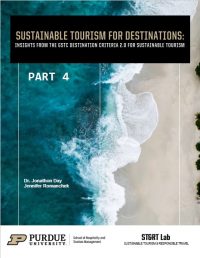Introduction

The Global Sustainable Tourism Council (GSTC), the leading organization on sustainable tourism accreditation, recently released their Destination Criteria 2.0. It provides a common framework for examining destination-level sustainable tourism certification. The GSTC Criteria are organized in four sections: sustainable management, socio-economic sustainability, cultural sustainability, and environmental sustainability. With these 4 sections there are 38 criteria and 174 indicators that destinations may use to assess their progress on achieving the criteria.
A New Perspective
This report (Part 4 of 4) will focus on the:
- Performance Management
Tourist destinations are complex systems. In this report, we use the term “destination” without designating a specific actor. It is important to note that we are not implying that either the local Destination Stewardship Organization (A1) or Destination Management Organization (DMO) is the sole responsible party.
Performance Management of Sustainable Tourism
Measuring progress is critical in achieving sustainability goals. All the activities discussed in the criteria should be monitored, and action taken if goals aren’t being achieved. It is important to recognize that each plan, policy, and program requires specific tracking and performance metrics. In some cases, destination level performance will be the aggregate of multiple stakeholders performance and programs will need to be implemented to gather data.
The GSTC Destination criteria provide a comprehensive set of indicators to support the implementation of sustainable tourism programs.
Monitoring Progress towards Sustainable Tourism
The GSTC criteria encourages measuring and monitoring the socio-economic, cultural and environmental issues and impacts arising from tourism [35]. The best programs will regularly monitor key indicators, evaluate progress and report it to stakeholders and the community.
Measuring the socio-economic contribution of tourism [36]
Destinations should have in place metrics that measure the direct and indirect impacts of tourism. The criteria suggests a range of measures including:
- Visitor numbers
- Visitor expenditure
- Employment rates
- Investment figures
- Evidence of distribution of economic benefits to the local community
Safety and Security [37]
Destinations have a system in place to monitor crime, safety and health hazards associated with visitors and residents.
Environmental Performance Measures
Sustainable Destinations communities should have systems in place to monitor key environmental indicators including:
- Water stewardships: monitoring of sources and volume used for tourism purposes and recorded effect on local communities and ecosystems
- Energy consumption
- Data of monitoring and mitigation actions to GHG emissions
- Data on visitor use of alternative transport modes for more sustainable means
- Identification and monitoring of potential sources of pollution related to tourism
Cultural and Heritage Performance Measures
Sustainable Destinations communities should have systems in place to monitor key socio- cultural indicators including:
- Evaluating and indicating level of vulnerability of cultural assets, artefacts and heritage
- Monitoring to ensure the presentation, replication and interpretation of culture ceremonies and traditions are respectful, authentic and approved by local and indigenous communities
- Visitor flows and impact on cultural sites
[35] A3: Monitoring and Reporting
[36] B1: Measuring the Economic Contribution of Tourism
[37] B7: Safety and Security
The is part 2 of a series of 4 parts:
- Insights from the GSTC Destination Criteria 2.0 – Part 1
- Insights from the GSTC Destination Criteria 2.0 – Part 2
- Insights from the GSTC Destination Criteria 2.0 – Part 3
- Insights from the GSTC Destination Criteria 2.0 – Part 4
Download: pdf file available here
Source: Dr. Jonathon Day & Jennifer Romanchek, School of Hospitality and Tourism Management
Sustainable Tourism and Responsible Travel Lab ( STaRTlab)
Purdue University | College of Health and Human Science
Web adaptation: Valentina Gambino




